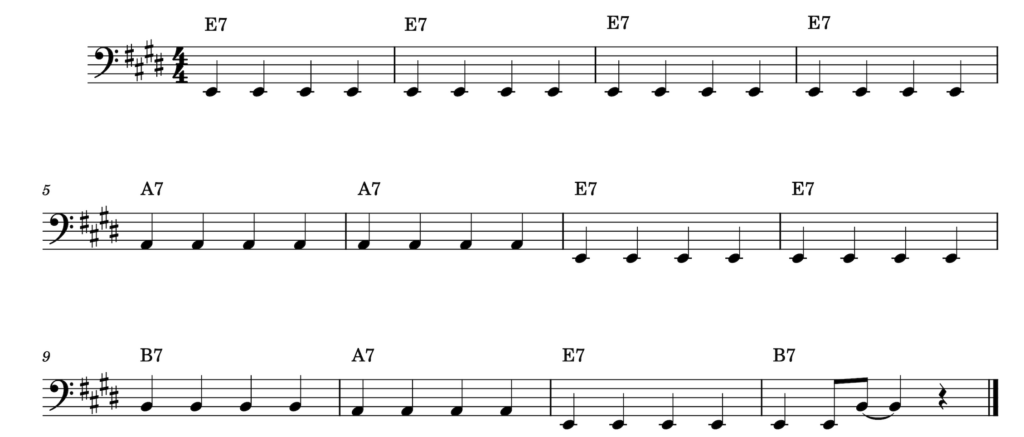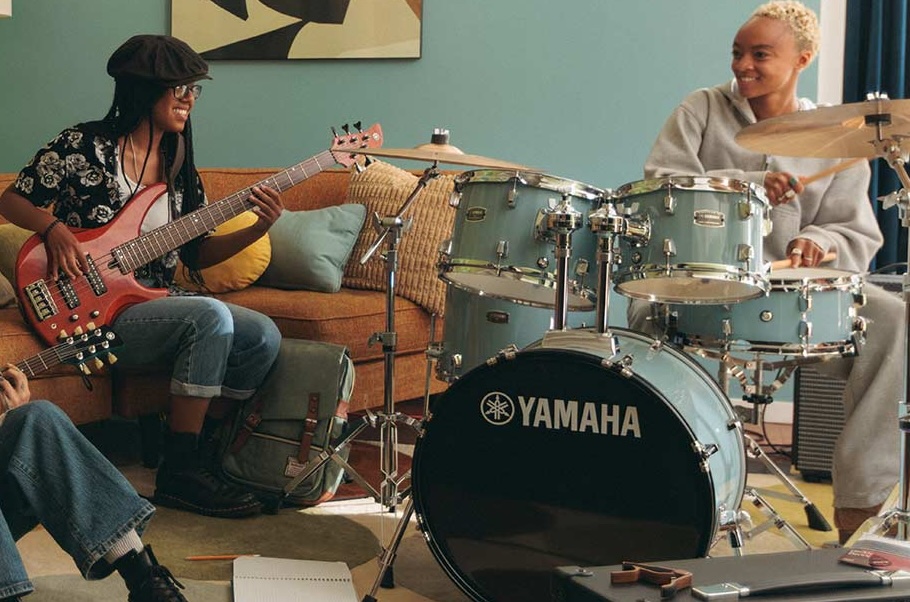How to Construct Walking Basslines
Learn to move from chord to chord with confidence.
Walking basslines create a sense of forward motion, or “walking,” by outlining chord changes in a smooth, connected way, usually one note per beat in a 4/4 time signature. A steady, flowing bassline helps drive the rhythm section, gives soloists a strong harmonic structure to improvise over and ties the whole band together.
Understanding chord progressions is essential to learning how to play walking bass lines. There are many common chord progressions used in different musical genres — including the ii-V-I, circle of fifths and minor ii-V-I that are often used in jazz — but learning to play a basic 12-bar blues is a great way to get started.
12-BAR BLUES
A 12-bar blues progression is based on the I, IV and V chords of a key. In the key of E, these chords are E7 (the I), A7 (the IV) and B7 (the V). Notice that they’re all seventh chords, which is why this progression is also known as I7-IV7-V7 blues; however, these are all dominant 7th chords instead of major 7ths.
The basic 12-bar blues structure is broken down into three four-bar sections. Bars 1 – 4 are E7, the root chord; bars 5 and 6 go to A7, the IV chord; bars 7 and 8 return to E7; bar 9 goes to the V chord, B7; bar 10 returns to A7; bar 11 is E7 again; and bar 12 is back to B7. Here’s what that chord progression sounds like on piano:
START WITH ROOTS
Begin by playing just the root of each chord on every beat, which will give you a sense of how to connect the harmony with the rhythm. Here’s what that looks like on a chart:

On a four-string bass, you can play the E at the seventh fret of the A string, the A at the fifth fret of the E string, and the B at the seventh fret of the E string. On a five-string bass, as shown in the video below, you can play the E at the fifth fret of the B string (or the open E).
Here’s what it looks and sounds like when you play just those roots on each bar:
ADD FIFTHS AND OCTAVES
When you’re comfortable with roots, try adding fifths. (You can actually get a lot done with just roots, fifths and octaves). On an E7 chord, this means playing E (the root) and B (the 5th); on an A chord, play both A and E; and on a B chord, play B and F#.
On a four-string bass, you can play the E at the seventh fret of the A string, the A at the fifth fret of the E string, and the B at the seventh fret of the E string. On a five-string bass, as used in the video below, you can play the E at the fifth fret of the B string (or the open E).
Start by hitting the root on beats 1 and 2 and the fifth on beats 3 and 4, as shown in the chart and video below.

ADD OTHER CHORD TONES
Besides the E and B, an E7 chord also includes G# (the 3rd) and D (the flatted 7th). Similarly, an A7 also contains C# and G, while the B7 chord has a D# and an A#:

Playing these chord tones as ascending arpeggios up to the 6th nicely outlines the harmony, as demonstrated in the video below:
USE PASSING TONES
Playing passing tones — the notes between chord tones — helps create smoother transitions between chords. Once you have your quarter notes down, play with rhythm and rests; approaching chord tones a half-step or whole step above and below can sound great, too.
Most bass players choose which techniques they want to use from moment to moment, mixing it up to keep it fresh for themselves, the other musicians, and the listeners. Here’s a video that shows a combination of several approaches:
PLAY ALONG
One of the best ways to learn walking is to listen to bassists you admire. In addition to listening to classic recordings, check out duo performances — bass and guitar, for example, or bass and piano — to hear great bass players clearly outline chord changes.
In addition, experiment with note length and explore different chord types, chord progressions, feels, tempos, and time signatures. Practicing with a metronome (as well as apps, loops or a minus-one backing track like this, with drums and guitar but no bass) — will help keep your time steady.
CHORD SUBSTITUTIONS AND TURNAROUNDS
You’ll notice that some play-along tracks (like this one and this one) substitute the IV chord instead of staying on the I chord in bar 2; others, like this one, also substitute chords in bars 8 and 9 before ending with a two-bar figure known as the turnaround, which takes us back to the beginning. Having a good knowledge of chord substitutions and learning turnarounds are crucial skills for every bass player, and although it may be more prevalent in jazz than in blues or other genres, understanding the concept will allow you to be comfortable in every situation that calls for you to confidently connect chords.
Happy walking!
For more information on creating walking basslines, check out this blog.














